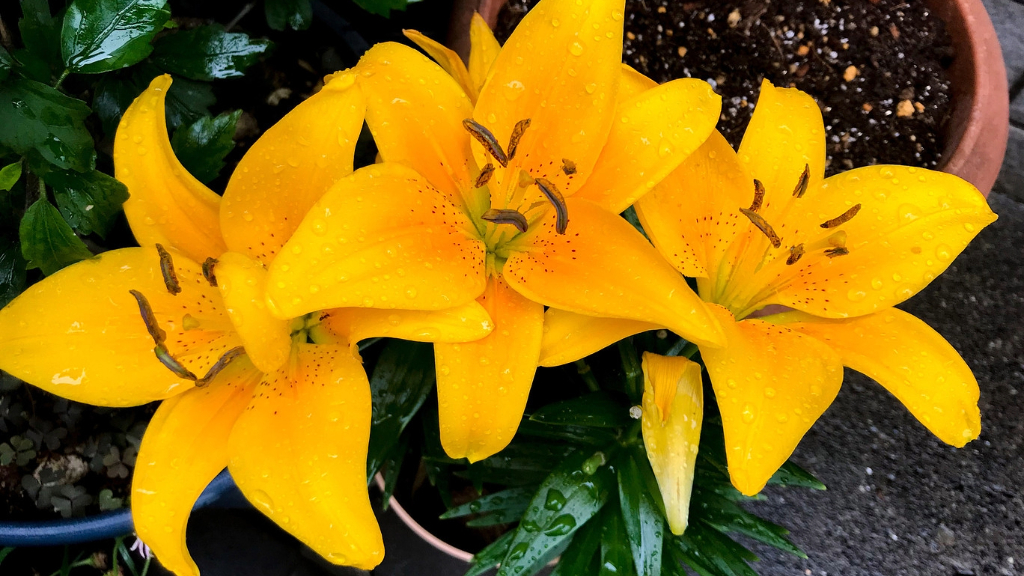Planting Lily Bulbs in Pots


"The rose is the flower and handmaiden of love. The lily, her fair associate, is the emblem of beauty and purity."
Dorothea Dix Lily bulbs are steeped in myths, history and symbolism. In Ancient Greece, it was believed that white lilies sprouted up from spilled breastmilk of the goddess Hera. Therefore, white lilies symbolize motherhood, femininity and purity - and were also associated with the Virgin Mary. Lilies are the traditional 30th anniversary flower, representing devotion and love.
They are also the birth flower for those born in the month of May. Lilies are traditional flowers for births, wedding and funerals, celebrating all the passages of life. Like roses, the color or variety of lily flowers also has specific meanings. White lilies can also symbolize peace, virtue and sympathy. Yellow lilies represent good health and healing. Orange lilies symbolize confidence, pride and wealth. Red lilies represent passion and love. Peruvian lilies symbolize friendship and devotion. Stargazer lilies represent ambition, wealth and prosperity.
If you want to communicate in the language of flowers, lilies are an open book.
Lily Container Growing
With all their symbolism and history, it's no wonder that lilies were named the Summer Bulb of the Year. Lilies are commercially grown as cut flowers, but unlike many of the blooms you'll find in a florist shop, lilies are extremely easy to grow in nearly any garden or container. Growing lily bulbs in pots has its benefits:
- It allows you to grow lilies even if you have limited space in the garden or on a balcony. In fact, lilies are long blooming plants that make excellent potted specimens for decks or patios.
- You can gift lilies to people for weddings, birthdays, anniversaries or funerals as potted living plants that will last much longer than cut flowers.
- Many varieties of container grown lilies will survive just as well indoors, as out in the garden. Just keep in mind that lilies are toxic to cats.
Lily bulbs need to be planted 2 inches (5 cm.) from other plants. If you choose to do containers with only lilies, try to select those with different bloom times to ensure that something is always in flower. Madonna lilies, Asiatic lilies and Trumpet lilies are all early to mid-summer bloomers. Oriental lilies, Nepalese lilies and Speciosum Hybrid lilies will pick right up where the early bloomers left off, about mid to late summer.
You will also want to pay attention to the mature size of the lily bulbs you've selected, so you can properly arrange them in container designs. Generally, the tallest varieties are planted in the center of the pot, with shorter varieties around them. This will give the container a nice symmetrical look that won't change if you turn or move the pot. However, taller lilies can also be planted toward the back of pots, with shorter varieties in front.
Gardening tips, videos, info and more delivered right to your inbox!
Sign up for the Gardening Know How newsletter today and receive a free copy of our e-book "How to Grow Delicious Tomatoes".
Many lily bulbs require a cold period to produce blooms, so this is another thing to research before planting.
Planting Lily Bulbs in Containers
Potted lily plants will require a medium to large pot, 10 inches (25 cm.) or more in diameter. The pot must have drainage holes, as lily bulbs will rot when the soil does not drain well. You can add a layer of rocks in the bottom of the pot for extra drainage. While this will make the container heavier, it can also help prevent the pot from tipping over.
The potting mix you use should be somewhat sandy, as lilies grow best in partially sandy soils. You can ensure the soil is slightly sandy by mixing 1 cup of sand to every 2 cups of regular potting mix. To plant lily bulbs in pots, fill the pot about one third full of potting mix. Then set the lily bulbs where you want them, 2 inches (5 cm.) apart. Gently cover the bulbs with enough potting mix so that just a small tip of the bulb is poking out of the soil.
At planting, you can also apply a slow release fertilizer for blooming plants if desired. Water your newly planted lily bulbs deeply, then do not water again until the soil surface is visibly dry. As the blooms fade, deadhead them to keep your potted lilies looking neat and encourage reblooming. As stated previously, potted lilies make excellent gifts.
There are hundreds of different choices for potted lilies, so it can be overwhelming. Fortunately, there are fabulous websites, such as Bulb.com, where you can find all the information you need about specific lilies as well as order healthy bulbs, which are essential for growing beautiful potted lilies.
-
 Zinnias On Repeat: 10 Glorious Cut-And-Come-Again Varieties For Endless Summer Bouquets
Zinnias On Repeat: 10 Glorious Cut-And-Come-Again Varieties For Endless Summer BouquetsThese zinnia varieties keep giving all summer, making them the perfect choice for dedicated cutting gardens – or just the occasional homegrown bouquet.
By Ellen Wells
-
 Create A Romantic Garden Straight Out Of Bridgerton: Regency Era Romance In Your Garden
Create A Romantic Garden Straight Out Of Bridgerton: Regency Era Romance In Your GardenTry some romantic garden ideas straight out of Bridgerton. Flowers and gardens in the Regency era were lush and charming and you can get the same look!
By Bonnie L. Grant